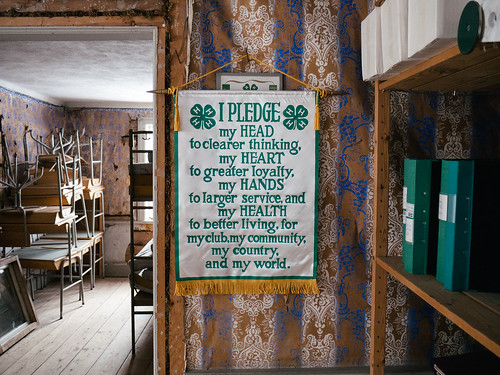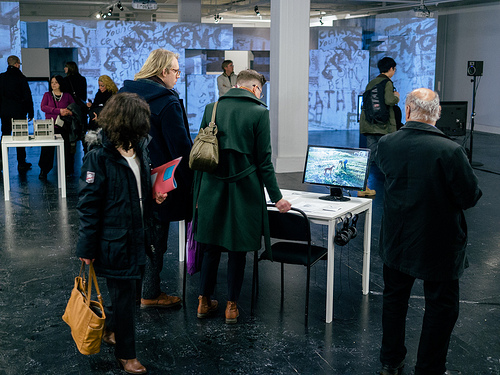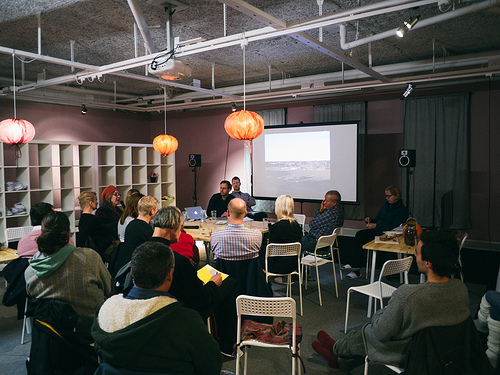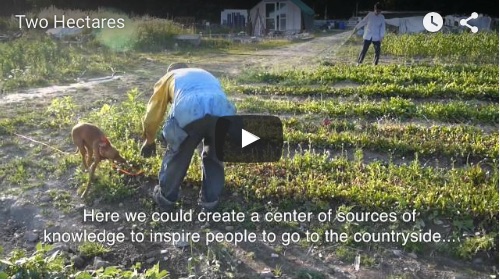"A Farm on the Countryside in the City" is a series of works that engage with the particular environmental and social context of Hästa gård in Stockholm. Hästa gård is a 200+ hectare farm located in a cultural reserve surrounded by suburbs built during the "million programme" in the 1960s and 1970s. It's Stockholm's only working farm and one of the worlds largest urban farms, located within 5 minutes walk from the nearest underground station (Akalla).

The photo above is from "Hästa gård - En bondgård på landet i staden", a report that traces various developments at Hästa gård from 2010 to 2014 and proposes ideas for future art and research activities at the farm. The report was presented in the exhibition "Tensta Museum; Reports from New Sweden" at Tensta konsthall along with a map / diagram outlining a proposal by artist and agroecologist Fernando Garcia-Dory on how to develop the ecological cultivation at Hästa gård and its social functions.

"Visions for The Countryside" was a roundtable discussion about art and agriculture on the Swedish countryside and at Hästa gård in Stockholm. The program included a screening of the short film "Two Hectares" and presentations by Fernando Garcia-Dory, Erik Sjödin and Per Hasselberg from Konstfrämjandet. Participants in the roundtable discussion included Rafael Altez Calderon, Föreningen för Den GULLIGA Folkrörelsen (DGF), Maria Lind from Tensta konsthall and Hästa gårds vänförening.

"Two Hectares" is a short film by Erik Sjödin and Fernando Garcia Dory. The film portrays Rafael Altez Calderon, who from 2010 to 2014 was working with a community that cultivated two hectares of land at Hästa gård. The film introduces Rafaels work with establishing an ecological cultivation at Hästa gård in order to support a transition to a social-ecological society and a re-activation of the countryside based on permaculture principles. Rafael and his association were evicted from Hästa gård in January 2014.

The following excerpt from Giovanna Di Chiro's essay Nature as Community contextualizes past and presents attempts at community building at Hästa gård. The excerpt points towards an idea of community that is inclusive rather than excluding.
Material produced within "A Farm on The Countryside in The City" has been shown at Tensta konsthall in the exhibition "Tensta Museum; Reports from New Sweden" 2013 / 2014. The project has been featured in Tate Etc. in the essay The Palate, the Palette and the Planet by Fanny Singer 2015. Thanks to Fernando Garcia-Dory, Rafael Altez Calderon / DGF, Tensta konsthall and Hästa gård.

The photo above is from "Hästa gård - En bondgård på landet i staden", a report that traces various developments at Hästa gård from 2010 to 2014 and proposes ideas for future art and research activities at the farm. The report was presented in the exhibition "Tensta Museum; Reports from New Sweden" at Tensta konsthall along with a map / diagram outlining a proposal by artist and agroecologist Fernando Garcia-Dory on how to develop the ecological cultivation at Hästa gård and its social functions.

"Visions for The Countryside" was a roundtable discussion about art and agriculture on the Swedish countryside and at Hästa gård in Stockholm. The program included a screening of the short film "Two Hectares" and presentations by Fernando Garcia-Dory, Erik Sjödin and Per Hasselberg from Konstfrämjandet. Participants in the roundtable discussion included Rafael Altez Calderon, Föreningen för Den GULLIGA Folkrörelsen (DGF), Maria Lind from Tensta konsthall and Hästa gårds vänförening.

"Two Hectares" is a short film by Erik Sjödin and Fernando Garcia Dory. The film portrays Rafael Altez Calderon, who from 2010 to 2014 was working with a community that cultivated two hectares of land at Hästa gård. The film introduces Rafaels work with establishing an ecological cultivation at Hästa gård in order to support a transition to a social-ecological society and a re-activation of the countryside based on permaculture principles. Rafael and his association were evicted from Hästa gård in January 2014.

The following excerpt from Giovanna Di Chiro's essay Nature as Community contextualizes past and presents attempts at community building at Hästa gård. The excerpt points towards an idea of community that is inclusive rather than excluding.
The place - geographical, cultural, and emotional - where humans and environment converge is embodied in the ideas and practices of "community." One concept of community advances group identification with common histories, experiences and endurances of oppression, whether racial, ethnic, gender based, or socioeconomic. This view of community is often said, in the language of social science, to represent a "unity of sameness." In other words, those whom we identify as members of our community we recognize as having similar or identical features. Other, less anthropocentric and, some would argue, less conservative conceptions of community exist, however, and emphasize the notion of "unity in difference." This idea of community presupposes connection to and interconnectedness with other groups, other species, and the natural environment through everyday experiences with family, comradeship, and work. The cultural theorists Laurie Anne Whitt and Jennifer Daryl Slack argue that communities should be understood as "sites where the human and other than human are drawn together in multiple articulations." They propose the term "mixed community" to signify the relations of interdependence that inhere in geographically diverse "mixed species" (human and nonhuman) assemblages. An environment contextualizes a particular mixed community, "situating it within and bonding it to both the natural world and the larger 'containing society'" Communities and environments are therefore conjoined and must be understood as being mutually constitutive. Whitt and Slack continue,
"Communities, then, are as much results as they are causes of their own environments. One practical consequence of this is that discussions of development cannot proceed reductively, by divorcing communities from their material contexts. Mixed communities and their constitutive environments are inseparable; they are the unit of development and of change. All development is for better or for worse, co-development of communities and environments. And the relation between a particular community and its environment "is not simply one of interaction of internal and external factors, but of a dialectical development" ... of community and environment in response to one another." - Giovanna Di Chiro, Nature as Community
"Communities, then, are as much results as they are causes of their own environments. One practical consequence of this is that discussions of development cannot proceed reductively, by divorcing communities from their material contexts. Mixed communities and their constitutive environments are inseparable; they are the unit of development and of change. All development is for better or for worse, co-development of communities and environments. And the relation between a particular community and its environment "is not simply one of interaction of internal and external factors, but of a dialectical development" ... of community and environment in response to one another." - Giovanna Di Chiro, Nature as Community
Material produced within "A Farm on The Countryside in The City" has been shown at Tensta konsthall in the exhibition "Tensta Museum; Reports from New Sweden" 2013 / 2014. The project has been featured in Tate Etc. in the essay The Palate, the Palette and the Planet by Fanny Singer 2015. Thanks to Fernando Garcia-Dory, Rafael Altez Calderon / DGF, Tensta konsthall and Hästa gård.